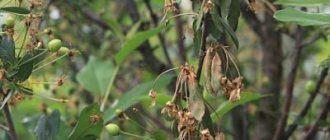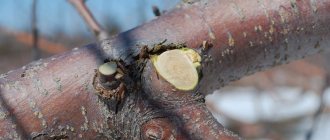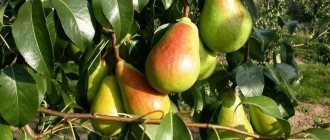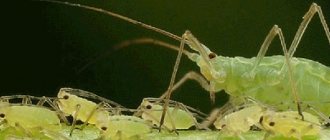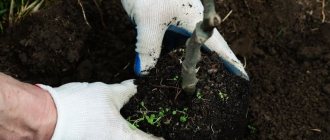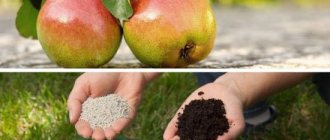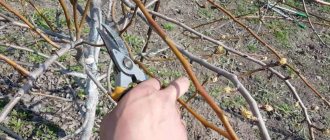It cannot be said that the situation when a pear seedling’s buds and leaves do not bloom in the spring is widespread, but it does happen. Most often this is due to unfavorable climatic conditions, but there are other reasons, so in the article I will answer the questions why the pear does not leaf out and what to do to help the tree begin to grow.
Buds and wood froze
The most common reason is that the pear could not withstand the cold and froze. This can happen due to fertilizing with nitrogen fertilizers in the second half of summer and autumn. Nitrogen compounds cause active growth of the vegetative mass; as a result, the wood does not have time to ripen by the beginning of winter and freezes out.
Another variation of this situation is that the death of branches (and sometimes the entire tree) can occur due to too harsh a winter.
To check whether a branch is alive or dead, you need to make a cut and inspect the wood. If the cut turns out to be partially or completely brown, it means that the branch has frozen and will not recover (healthy pear wood is beige).
Frozen branches should be cut back to living tissue, and the cut must be covered with garden varnish. If there is a suspicion that the entire tree has died, carefully cut out a small piece of bark on the trunk and examine the cambium: its green color indicates that the pear is alive, and its brown color indicates that no measures will help the pear recover.
If dormant buds above the graft awaken on a frozen pear, the variety can still be saved.
Planting zoned varieties suitable for a specific growing zone will help minimize the risk of pear trees freezing. The most winter-hardy, suitable for planting in the Urals and Siberia, include:
- "Autumn Dream";
- "Dekabrinka";
- "Severyanka";
- "Fairytale";
- "Lukashovka";
- "Uralochka";
- "Chizhovskaya";
- "Svarog";
- "Perun".
For central Russia, you can consider the varieties “Dessert Luxurious”, “Bananavaya”, “Belorusskaya Late”, “Bryansk Beauty”, “Vernaya”, “Thumbelina”, “Lada”, “Moskvichka” and others.
Proper preparation of wood for winter
Often the reason that pears do not bloom on time is improper preparation of plants for winter. In order for the tree to feel comfortable, it is necessary to carry out autumn cleaning: all fallen and spoiled fruits, as well as carrion, must be removed.
Fallen leaves are burned or used for compost. Why shouldn't it be left to feed trees? This significantly increases the risk of spreading various parasites. Naturally, this way you deprive the soil of its usual nutrients, but it is better and safer to replenish their supply with mulch or fertilizers.
The next step in preparing the tree for wintering will be pruning. All damaged branches are removed, the crown is sprayed from scab. Existing bark defects are cleaned and treated with a solution of copper sulfate.
To prevent trees from freezing, you can increase their resistance with the help of phosphorus or potassium fertilizers. Nitrogen-containing preparations are not suitable in this case.
The pear tree does not bloom after winter if the autumn is dry. In this situation, it is worth resorting to moisture-charging irrigation - up to a ton of water is poured under each adult plant.
The revival of a tree in spring is often prevented by rodents. To keep them away from young plants, wrap the trunks with burlap or special plastic covers. The pear is a very capricious tree, so pay it due attention in the fall in order to get a good harvest in the future.
The roots are frozen
If the winter was not only harsh, but also with little snow, then there is a possibility that not only the crown, but also the roots of the tree would freeze. Even if the pear leaves have not blossomed in May-April, do not rush to cut it out, because... sometimes the root system partially freezes out, and in this case the tree may begin to grow a little later.
Most often, young seedlings suffer, whose root system is not yet powerful and superficial enough. Freezing occurs more often at the beginning of winter, when there is almost no snow, and measures have not been taken to cover the tree trunk circle.
You can prevent freezing of the roots by mulching. It is carried out depending on the region from the end of September to November. The tree trunk circle should be insulated while the ground is not yet frozen. For mulching you can use:
- humus;
- compost;
- sawdust;
- dry leaves.
First, the soil in the tree trunk circle needs to be loosened for better aeration and drainage of the soil. The recommended thickness of the mulch layer is 5-7 cm. With the arrival of frost, more snow is thrown into the tree trunk circle for additional protection.
Viral infections
Viruses are intracellular parasites that reproduce only in the affected cell. Outside living cells, viruses are inactive and do not have their own metabolism.
They invade a living cell and force it to produce copies of viruses. In this case, the cell usually dies. Viruses can infect bacterial cells and suppress the immune system of the infected cell.
Viral diseases are characterized by the following leaf changes:
- shape deformation;
- stunting, dwarfism;
- mosaic of leaves.
Pears rarely suffer from viral diseases, however, they are also found on the fruit tree. Viral diseases include:
- fruit stonyness;
- mosaic;
- witch's broom;
- grooves of wood;
- subcutaneous viral spot of pear.
Stoneiness of the pear fruit
This is pitting disease. It is reflected on the leaves, fruits, and trunk. The leaves are covered with blurry yellow-green spots, yellow veins stand out on them. Dark green areas appear on the fruits. In this place, the tissue of the pear does not grow, which is why pits form and the pear becomes bent.
The fruits are twisted and tasteless, their tissue becomes woody. The pear bark is covered with watery pimples. Over time, the blisters burst and the tissue underneath dies. Young trees are less susceptible to disease. It is unknown how to deal with pitting disease; prevention is important.
Mosaic
Pronounced changes in leaf color. Lighter spots appear on them. Next, the veins turn yellow, and then we get the formation of yellow spots, which indicates infection with the yellow mosaic virus.
Infectious chlorosis of green pear leaves is most often carried by aphids, but the infection can be spread by pollen or through damage to the bark. Infected leaves die and the yield is reduced by half. Diseased trees are uprooted.
Witch's broom
This is a viral or fungal disease that affects pears. At the site of infection, thin shoots begin to grow in large numbers, forming a dense, round cluster on the branches, similar to mistletoe. These shoots are covered with underdeveloped leaves, which soon curl and fall off.
Light white lumps are characteristic of a fungal infection. If this is a viral disease, then the pear will not survive, the disease is fatal.
Why this disease appears in pears has not yet been clarified. There is no cure for the disease; the tree writhes and is burned.
Grooving of wood
The disease most often appears on young 2-3 year old pears. Cracks similar to frost holes form on the bark. The infection penetrates through them, the communication between the roots and leaves is disrupted. The branches begin to curl, dry out, and are stunted in growth. The leaves also curl up and the tree cannot bear fruit.
The disease is difficult to treat and there are no reliable cures. The tree is removed from the garden along with its roots.
Subcutaneous viral spotting
The disease leads not only to a reduction in the harvest, but also to the rockiness of the grown fruits and to the loss of their taste. A dent forms in the area where the fruit is affected, and the pear becomes crooked.
Pear leaves change color, become covered with light spots, and dry quickly. Cracks appear on the trunk and branches.
The disease cannot be cured and is transmitted by insects that feed on the sap. For example, aphids or psyllids.
Infection can occur through grafting with infected cuttings. Pears with detected infection are uprooted and burned. To prevent the disease, preventive spraying is carried out:
- in spring, spray with Nutrofen on bare branches;
- before flowering, spray with 0.4% Zineb or 0.4% copper oxychloride solution;
- after flowering, treat the plant with 1% Bordeaux mixture;
- repeat treatment after 2–3 weeks.
Antiviral drugs are effective only in the early stages of the disease and for prevention purposes. There are practically no cures for diseases caused by viruses. The affected plant is dug up and burned.
Severe lack of moisture
Experienced gardeners know that a significant lack of moisture negatively affects fruit trees throughout the season, including during wintering. Despite the fact that in winter the branches of the pear are bare, it still continues to evaporate moisture. In addition, in moist soil the roots are better protected from frost, which increases the chances that the tree will have a good winter.
That is why it is better to carry out moisture-recharging irrigation in the fall. Its need increases if the winters in your region have little snow and the summers were dry.
To determine whether a tree needs water-recharging watering or not, you should dig a hole as deep as a spade bayonet, and then try to form a lump of soil from the bottom of the hole. If this fails, you must water it.
Water-recharging watering should be plentiful. Water application rates:
- young seedlings - at least 40 liters;
- adult pears – 70 liters;
- trees older than 15 years – 100 liters.
Autumn watering is carried out after leaf fall. Depending on the region, these dates fall in the second half of October or early November.
Measures to prevent the problem
The orchard needs careful care. Starting from the first months of spring, you need to take care of fruit trees:
- trim in a timely manner;
- feed;
- water moderately;
- cover for the winter.
In addition, do not forget about preventive treatment that protects the crop from diseases and pests. Then a pear tree standing in full bloom will become a common sight.
During landing
For this procedure, you need to select a well-lit area with fertile soil in advance. In order for the seedling to quickly take root, you need to correctly position it in the hole, having first straightened the roots. Having completed planting, the tree is watered abundantly and the soil is mulched with organic matter.
Nuances of care
The conditions for growing pears may seem difficult only for beginners. Fruit crops need:
- weekly watering - 6-8 buckets for each plant;
- 2-3 feedings per season;
- annual pruning.
In addition, for the first 2-3 years after planting, the plant needs reliable winter shelter that protects underdeveloped roots from severe frosts.
Incorrect landing site
For the normal development of the pear, the choice of planting site is of great importance. The crop is not planted in places with high groundwater levels or in areas with dense clay soil, because in this case, the root system of the pear will suffer from oxygen starvation, which can ultimately lead to a stop in development and the death of the tree in the future.
If the place for planting the pear was chosen incorrectly, the tree looks depressed and does not bloom buds and leaves - it can be replanted, provided that at this moment it is no older than 3-4 years. At an older age, a pear in a new place will either take a long time to take root or will not take root at all.
The seedling is transplanted onto an artificially created hill or a high place. The clay soil for filling the planting hole is improved by adding peat and coarse sand, and a 10-centimeter layer of crushed stone is laid on the bottom as drainage.
You can view complete information about the rules for planting and caring for pear trees here.
Reanimation of a seedling
If low-quality planting material was purchased, then the situation must be corrected before planting. If the seedling has roots in the form of stumps, do not worry, feel free to plant it. To avoid problems with it in the future, cut off the branches, leaving only the stumps. First, the roots will grow, and then the above-ground part itself.
Pruning a young pear
Pear pruning
If the seedling has dried out, then prepare a solution consisting of a bucket of water, urea (1 tbsp), superphosphate (1 tbsp) and root (a few drops). The plant is soaked in it for a day.
Important! If after planting the buds began to bloom, and then suddenly dried out, pruning will save you. Everything that is 5 cm above the grafting is cut off, leaving one shoot.
Damage to the trunk
This problem is identified quite simply. Damage to the trunk can be caused both by the activity of rodents (as can be seen from the characteristic teeth marks on the wood and eaten bark), and by sunburn, which looks like deep cracks in the bark.
Burns occur as a result of strong differences in day and night temperatures in winter. These vibrations can cause cracking of the bark on the trunk. Sunburn occurs especially often on the southern and southwestern sides of the trunk.
Damage must be repaired in a timely manner, for which the following measures are taken:
- Clean the damaged area with a stiff wire brush until healthy tissue is removed.
- Treat wounds with brilliant green, 2% copper or 5% iron sulfate.
- Create a protective layer from garden pitch or RanNet putty paste.
To protect the tree from this scourge in the future, preventive measures are used. The pear will be protected from sunburn by whitewashing the trunk and skeletal branches with lime - the white color reflects the sun's rays well, thereby protecting the bark from overheating. Young trees especially need protection.
To prepare the composition use:
- 5 liters of water;
- 1 kg slaked lime;
- 150 grams of copper sulfate.
After mixing the components, you should get a mass with a consistency reminiscent of thick sour cream. Pear trunks are whitened after leaf fall, when the air temperature drops to +4-5° C. Before this, the trunks are cleaned with a stiff brush to remove loose bark, growths, and lichens.
Effective protection from rodents will be provided by covering the trunk to a height of one to one and a half meters from the soil level. The winding should consist of dense materials that will be difficult for rodents to damage. It could be:
- spunbond, lutrasil and other agrotextiles;
- a structure made from several plastic bottles with a cut out bottom, the lowest bottle must be buried 10-15 cm into the soil;
- scraps of plastic pipes, cut lengthwise and fastened with wire;
- fine-mesh plastic or metal mesh, slightly buried in the ground.
Pear tree does not bloom after planting
Sometimes pear seedlings look vigorous after autumn planting, but with the arrival of spring they are in no hurry to open their buds. In this case, such behavior can be considered a variant of the norm - young trees need time to adapt to a new place. Wintering could also have a negative impact on their development.
On such seedlings, leaves can bloom only by the end of May, and sometimes later. It is necessary to continue caring for the pear, and get rid of it only if there are no leaves and growth until the fall.
